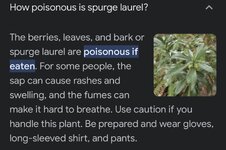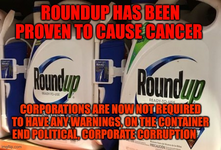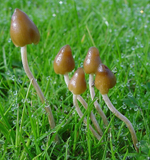A few days ago, I acquired a problem that I hadn't known about before. Meaning, it was never a problem for me but I guess it was there. For somebody.
My doorbell rang, which is most unusual. I answered it and there stood a neighbor whom I've known for well over 30 years. A very nice, quiet spoken older person. Our respective sons went to school together at one time.
Clutched in this lady's hand was a copy of the Wash. state guide to invasive species plants. She proceeded to tell me that I have a cluster of Spurge Laurel growing out by the road in front of my property. Spurge Laurel I'd never heard of, but I'm aware of the plant without being able to ID it. Because it's one of the few things that will grow and prosper in the shade of mature forestation.
The offending plants were actually growing on the county road right of way, which I take care of. I've planted some lupines by seed out there, plus I take care of the salal and a non-native photinia. But what the hey, she's seen me out there puttering around, so I figured I'd take responsibility for the issue. The lady told me Spurge Laurel seeds propagate easily and can infest native forests. She advised that I should remove the plants, and doing so would also be for the benefit of my neighbors. I told her I'd take it under advisement.
I considered the matter. I didn't really want to remove the Spurge Laurel, mainly because it does well where other plants don't really want to grow. Including under trees in compacted, rocky soil such as exists along roads. But the next day, I went out there and removed all the Spurge Laurel. I filled in the area with a few heather plants (also not native, but "allowed" because they haven't been deemed invasive) I was looking for homes for. I considered just forgetting about it. However, I've known this lady for a long time, figure this is something that she feels strongly about, so for her sake, I complied. BUT: I didn't remove the Spurge Laurel that grows on my side of the fence, which she cannot see. I have a few patches of it here and there around my property but in the conditions extant, has been slow-growing and has chosen to exist in places where it isn't displacing native plants.
Speaking of invasive, non-native plants, I didn't see English Ivy on the state's hit parade of forbidden plants. I've had a battle going for decades keeping it at bay. Some knuckle-head who owned my property previously planted some that got out of hand. I spent quite a bit of time removing it, including roots which is a real job of work. In the meantime, some got over onto the property east of mine which was undeveloped at the time and it took over a large area. Eradicated on my lot, I now have to fight ivy coming back this way again.
In the north end of my land I discovered an invasion of another invasive, non-native species called Yellow Archangel, I think it is. A neighbor on that side discarded a florist''s living plant pot in his yard. From there, the Yellow Archangel went onto my land, and two lots west of me. I tore it all out on my side of the fencing, but it's going crazy on three adjoining lots. I go out there a couple of times a year and rip out the tendrils that are trying to re-invade.
My doorbell rang, which is most unusual. I answered it and there stood a neighbor whom I've known for well over 30 years. A very nice, quiet spoken older person. Our respective sons went to school together at one time.
Clutched in this lady's hand was a copy of the Wash. state guide to invasive species plants. She proceeded to tell me that I have a cluster of Spurge Laurel growing out by the road in front of my property. Spurge Laurel I'd never heard of, but I'm aware of the plant without being able to ID it. Because it's one of the few things that will grow and prosper in the shade of mature forestation.
The offending plants were actually growing on the county road right of way, which I take care of. I've planted some lupines by seed out there, plus I take care of the salal and a non-native photinia. But what the hey, she's seen me out there puttering around, so I figured I'd take responsibility for the issue. The lady told me Spurge Laurel seeds propagate easily and can infest native forests. She advised that I should remove the plants, and doing so would also be for the benefit of my neighbors. I told her I'd take it under advisement.
I considered the matter. I didn't really want to remove the Spurge Laurel, mainly because it does well where other plants don't really want to grow. Including under trees in compacted, rocky soil such as exists along roads. But the next day, I went out there and removed all the Spurge Laurel. I filled in the area with a few heather plants (also not native, but "allowed" because they haven't been deemed invasive) I was looking for homes for. I considered just forgetting about it. However, I've known this lady for a long time, figure this is something that she feels strongly about, so for her sake, I complied. BUT: I didn't remove the Spurge Laurel that grows on my side of the fence, which she cannot see. I have a few patches of it here and there around my property but in the conditions extant, has been slow-growing and has chosen to exist in places where it isn't displacing native plants.
Speaking of invasive, non-native plants, I didn't see English Ivy on the state's hit parade of forbidden plants. I've had a battle going for decades keeping it at bay. Some knuckle-head who owned my property previously planted some that got out of hand. I spent quite a bit of time removing it, including roots which is a real job of work. In the meantime, some got over onto the property east of mine which was undeveloped at the time and it took over a large area. Eradicated on my lot, I now have to fight ivy coming back this way again.
In the north end of my land I discovered an invasion of another invasive, non-native species called Yellow Archangel, I think it is. A neighbor on that side discarded a florist''s living plant pot in his yard. From there, the Yellow Archangel went onto my land, and two lots west of me. I tore it all out on my side of the fencing, but it's going crazy on three adjoining lots. I go out there a couple of times a year and rip out the tendrils that are trying to re-invade.














